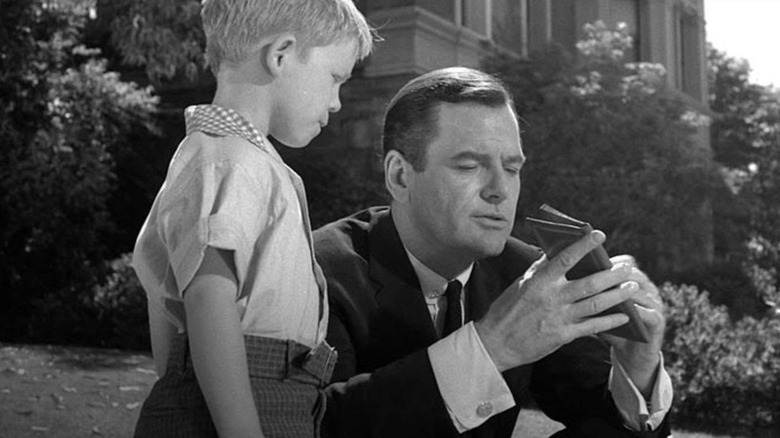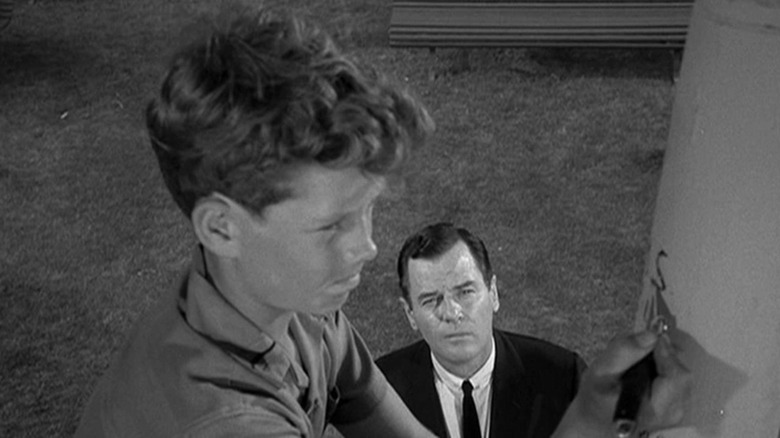Rod Serling's Most Personal Twilight Zone Episode Nearly Didn't Get Made
Rod Serling's "The Twilight Zone" delves into everything from the delightful to the macabre, where every incident exclusively takes place in the mysterious, unpredictable Twilight Zone. While some episodes lean into the deep-rooted fears of human existence, others probe into speculative fantasies about extraterrestrial life, time travel, and dream states that feel all too real. However, one particular episode of the show stands out: episode 5, "Walking Distance," is a deeply poetic and personal exploration of childhood nostalgia and the importance of moving forward, where some details were drawn fondly from Serling's personal life.
In the episode, a media executive named Martin Sloan (Gig Young) ends up near his childhood home in Homewood after his car breaks down within walking distance from his town. Serling based some of the details for Homewood on his own experiences of growing up in Binghamton, New York, and even inserted self-referential details such as a plaque near a carousal that reads "Rod Serling: Creator of 'The Twilight Zone.'"
The story takes a more bittersweet turn when Martin realizes that he has been transported to 1934 and sees his childhood self in the park he grew up playing in. Despite several desperate attempts to reach out to his younger self and his family, Martin is rejected and ends up learning a valuable lesson: clinging to the sentiment of going home, and returning to childhood, only hinders one from embracing life in the present with zest. Sometimes, it is essential to let go when there's no way back.
"Walk Distance" is still considered one of the best episodes of "The Twilight Zone," but according to Marc Scott Zicree's "The Twilight Zone Companion," it almost didn't get made after Serling first pitched it to CBS network Vice President William Dozier.
Hours of sincere persuasion
"The Twilight Zone" producer/writer Buck Houghton, along with Serling, presented some of the scripts to Dozier after the production and sale of the pilot, "Where Is Everybody?" Houghton recalled how the pilot was still plausible, but Dozier was resistant towards accepting episodes that waded deep into the waters of the liminal Twilight Zone:
"The pilot could have happened. This was about a guy in a space machine who got claustrophobia to a point where he thought he was the only man in the world. That was one of the two or three 'Twilight Zones' that could have happened. The next script that Bill Dozier read was 'Walking Distance,' about a guy who walks into his hometown hale and hearty and comes back with a limp that he got as a child, and Dozier said, 'Bullsh**! This doesn't work. Who the f**k's going to believe this, Rod?'"
When Serling and Houghton sat down with Dozier to convince the man about the appeal of the story, the network VP expressed his skepticism about audiences receiving such an ambitious idea in good faith. However, Serling was able to put his point across about the power of imaginative fiction, where established traditions can be broken to evoke myriad emotions. After several lengthy, two-hour discussions, Dozier finally came around:
"We got through the two-hour conferences, and the next time I heard of it, Bill was totally supportive. He'd been convinced to jump off the deep end and he was with it. So when sponsors started to say, 'Hey, what's this?' he said, 'Well, that's what you bought'. He acted just like he'd never had any objections himself, which was great."
Thanks to Dozier's support, we have "Walking Distance," which excels in positing the bittersweet themes that were so personal to Serling.

